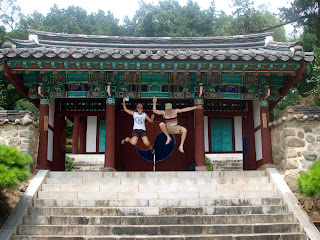The bus drops you off at the Express Bus Terminal which is on the side of a huge shopping center called U-Square (유스퀘어) which includes the Shinsegae Department Store as well as loads of restaurants and an Imax Theater. Behind the Shinsegae is an E-Mart, and behind the E-Mart is Kumho World, a large, multi-story electronics outlet store To get to the Bus Terminal by Subway, get off at exit 5, "Nongseong Station", it's about a ten-minute walk to the terminal, and is well sign posted.
Thanks to the following website, here is a link from Galbijim which shows you the Bus Timetables:
The official website is in Korean, but it is nevertheless user-friendly. For information on express busesclick here and either click where you want to go on the map, or choose the destination from the drop-down menu. For information on direct buses,click here. If all routes are not displayed, enter the desired destination and click "검색" for search.We stayed in a very cheap Motel (Just across the road from U-Square) as we had arrived so late. There are plenty of Motels surrounding U-square, and require some bartering to get the prices lowered. The motel cost us W55 000 for 2 rooms for the night but was VERY basic. We didn't have any other choice but to stay in a Motel, but \i would recommend finding alternative accommodation if you have the time.
The next morning we had coffee at a wonderful coffee shop just across the road from U-Square which had internet access and very friendly staff.
As we had some time in Gwangju, we set out to see Yangsan Market, Gwangju Hyanggy and the 5 Story Stone Monument.
Yangsan Market is at the Yangsan Market Subway Exit, and is full of bright colours, interesting smells and wonderful sights.
Gwangju Hyanggyo and the 5 Story Stone Monument are both is the same area of Gwangju. Take the Subway to Geumnamno 4(sa)-ga and head towards Gwangju Park.
Gwangju Hyanggyo was probably established in the early 15th century. Originally it was located at the base of Mt. Seosuk but was moved to the present location in 1488 because of frequent attacks by wild tigers. It was burned in 1597 during the Japanese invasion and rebuilt in 1600. Another major fire occurred in 1910 but was rebuilt by the mayor of Gwangju.
The upper courtyard consists of a central shrine (Daeseongjeon) with two smaller shrines facing each other. The central shrine contains memorial tablets to Confucius, Chinese Confucian scholars, and various Korean scholars. The east and west shrines (Dongjae and Seojae) enshrine various local scholars. The courtyard below the shrines is flanked by student dormitories on the east and west and a lecture hall (Myeongryundang) on the south side. To the west of the lecture hall and dormitories are several subsidiary buildings built in later years.
Just behind the Hyanggyo is Gwangju Park, which is a lovely spot to stroll around and absorb some ancient history. It is at the top of the park's hill that you can find the 5 story stone Pagoda. The hill is in the centre of town is the shape of a turtle, It was believed that the spirirt of Gwangju city was in the hill, and so a 5 story stone pagoda was built on the neck of the turtle to try and keep the spirit.
Gwangju is a great city with so much to see and do (much more than we could hope to see in 1 afternoon) and is a great way to explore more of what South Korea has to offer.









No comments:
Post a Comment